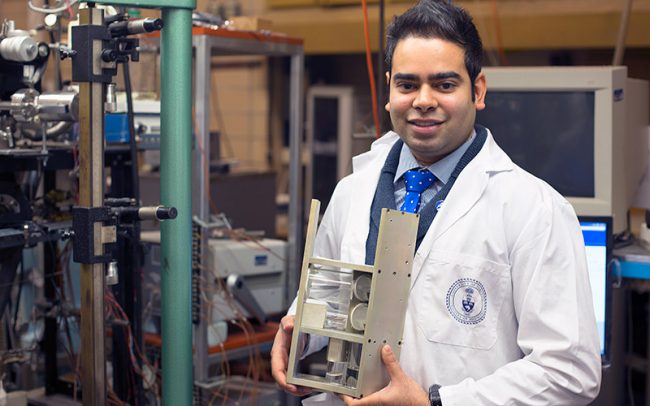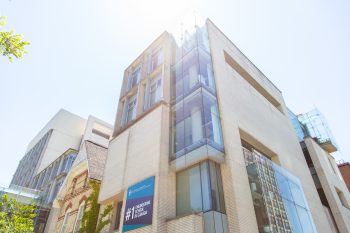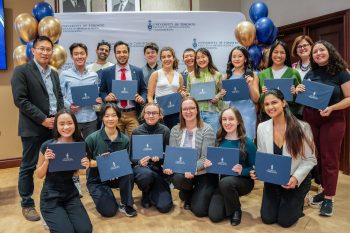For Aaron Persad (EngSci 0T6, MechE MASc 1T1, PhD 1T4) ‘reach for the stars’ is far more than a clichéd phrase on a graduation card.
“It may sound a bit wild, but I’m training as a commercial astronaut,” said Persad, who graduated on November 18 with a PhD in mechanical engineering—one of 386 engineering students who walked across the stage at Convocation Hall this month.
But when you account for all the diverse and disruptive things Persad has built, taught, experimented with and discovered since his days as an undergraduate in engineering science at the University of Toronto, wrapping up his PhD to become a commercial astronaut seems like a natural step.
Persad’s undergraduate thesis explored shuttle launch vibrations on stem cells, and he interned with the Canadian Space Agency’s flight research laboratory. This meant assisting with experiments performed in free fall among other projects. Professor Emeritus Charles A. Ward (MIE) then took Persad on for PhD work looking into the nature of evaporation with implications for liquid use in space—resulting in some provocative conclusions.
“At one conference in Naples, Italy, I remember scientists from half of the room were arguing with the other half about what I had just presented,” he said.
Between pushing forward the science in his field, gaining hands-on research with astronauts and finding a job that will have him floating at the edge of space, Persad also made time to found a company teaching robotics to six-year-olds and win an award for innovations in teaching that were later published in a scholarly journal.
“Our entire robotics education business is built on the idea that kids can learn complex ideas with one-on-one mentoring,” he said, adding this approach allows his company to teach university-level curriculum to grade-school kids.
Below, Persad explains how U of T Engineering supported his interest in discovery and why he’s working to inspire the next generation of engineers.
Why leave research on the ground behind you?
Being weightless is an incredible feeling. During my undergrad professional experience year (PEY) with the Canadian Space Agency, part of my job required me to fly in the Falcon-20 aircraft operated by the National Research Council out of Ottawa and I had the opportunity to experience weightlessness. It felt fantastic. I remember my legs had the tendency to float up toward my chest; I had to consciously keep them down. The training I do now with Astronauts for Hire, at the NASTAR Centre, is a very different experience: they simulate a Virgin Galactic space ship launch using a human centrifuge. You are exposed to forces up to six times that of Earth’s gravity. Imagine six of your clones standing on your chest!
Tell us a bit about the research that earned your PhD.
My research applies quantum mechanical principles to the evaporation of liquids. Some interesting (and controversial) discoveries were made in my PhD work and my experimental results could not be explained with conventional theories. Presenting this work at conferences made for lively discussions during the question periods.
What are you doing after graduation?
I’ve already completed suborbital training at the NASTAR Centre in Pennsylvania with Astronauts for Hire, the same facility Virgin Galactic uses to train their flight crew—and training will continue into next year.
I’ll also be working with Integrated Spaceflight Services, where I’ll manage the integration of experiments funded by NASA into a zero-g aircraft. The aircraft provides a near-weightless environment where everything inside will float for intervals of 20 seconds. It’s basically the same feeling that astronauts experience in the International Space Station, only for a much shorter duration.
As co-founder of TMS Robotics and Academics, I’ll continue to teach kids how to build and program robots.
And I’ve also been working with my supervisor, Professor Charles Ward, and Dr. Bjarni Tryggvason on an experiment scheduled for launch to the International Space Station with SpaceX in December.
What motivates you?
There is so much to discover in the world. My PhD work investigated the evaporation of water and other liquids. It may seem common knowledge that water evaporates, but it was amazing to discover that no one really knows how. Think of all the processes that rely on evaporation, such as weather forecasting, searching for water vapour on distant planets, or making efficient heat sinks for a tablet computer. Imagine how much more accurate storm forecasting could be, or how much more efficient electronics devices can be if we understood evaporation at a quantum mechanical level. My PhD work suggests that these improvements are within our grasp, and I was the lucky one reaching out to it.
How did U of T help you get to where you are?
I’ve had amazing support from faculty, friends and family at U of T. My cousin is graduating the same day as I am.
It was through my PEY supervisor, Dr. Marcus Dejmek at the Canadian Space Agency, that I met my PhD supervisor. Professor Ward has a great deal of experience in space sciences (having flown experiments on rockets and the Space Shuttle) and I knew I wanted to work with him. His willingness to let me try new and risky ideas led to some unique discoveries and made my PhD work so much more exciting to work on.
I was also hired by the mechanical and industrial engineering department to teach a capstone robotics course and this proved to be valuable experience in launching my own robotics education company, TMS Robotics and Academics.
It was through travel grants from the School of Graduate Studies and MIE that I was able to attend conferences and present my work. I met many experts from space agencies worldwide, including NASA. It was through networking at these conferences and showcasing the quality of my research with Professor Ward that I was ultimately selected as a commercial astronaut candidate. The MIE department has been very supportive of my work, and I was pleased to have been nominated by them for teaching awards.
See this month’s other graduating students in our Convocation Fall 2014 photo gallery.



